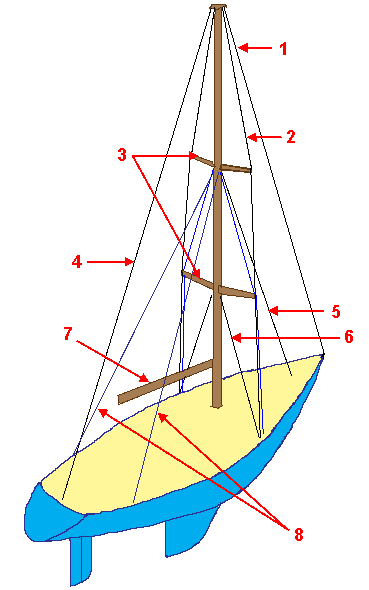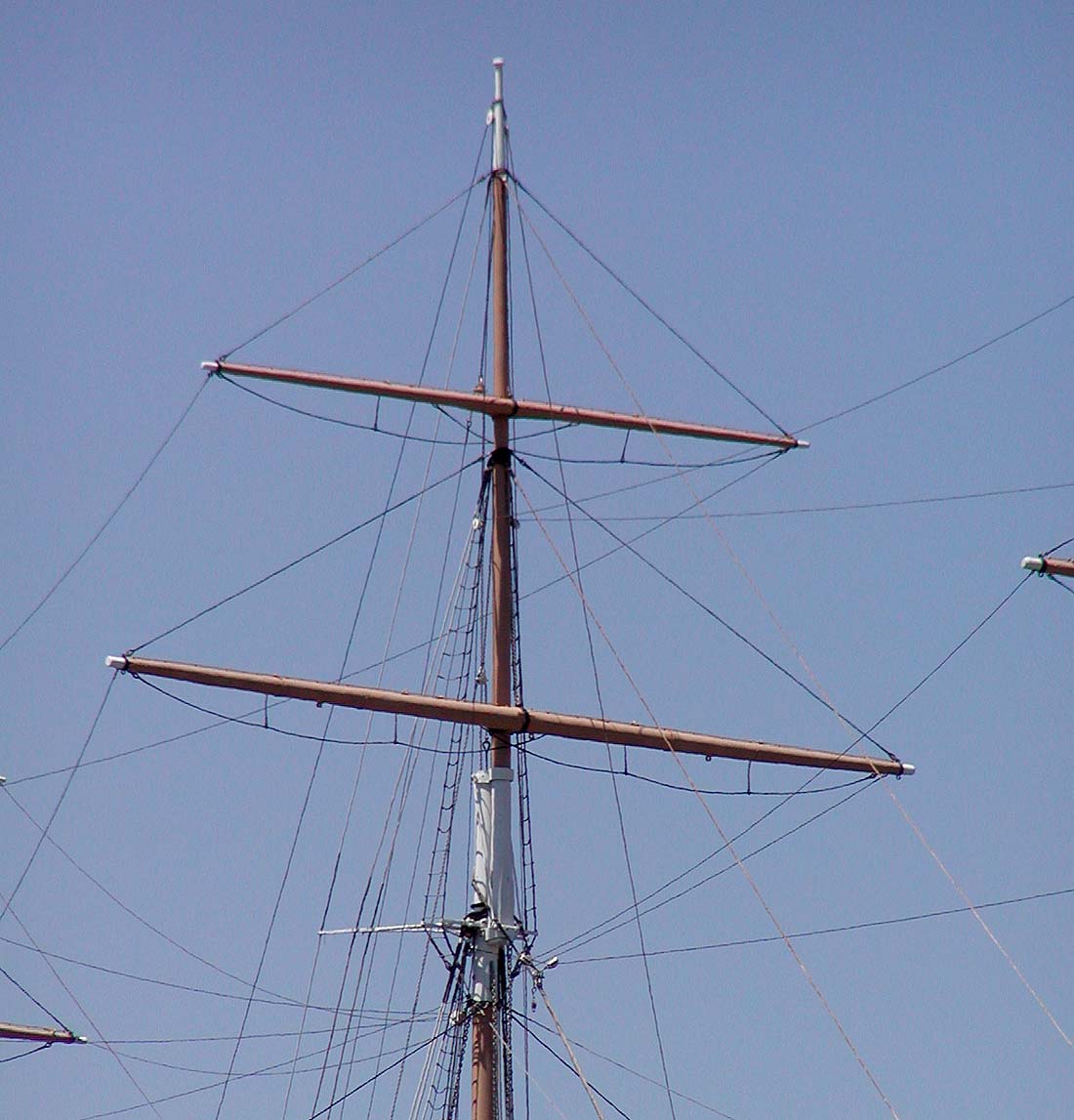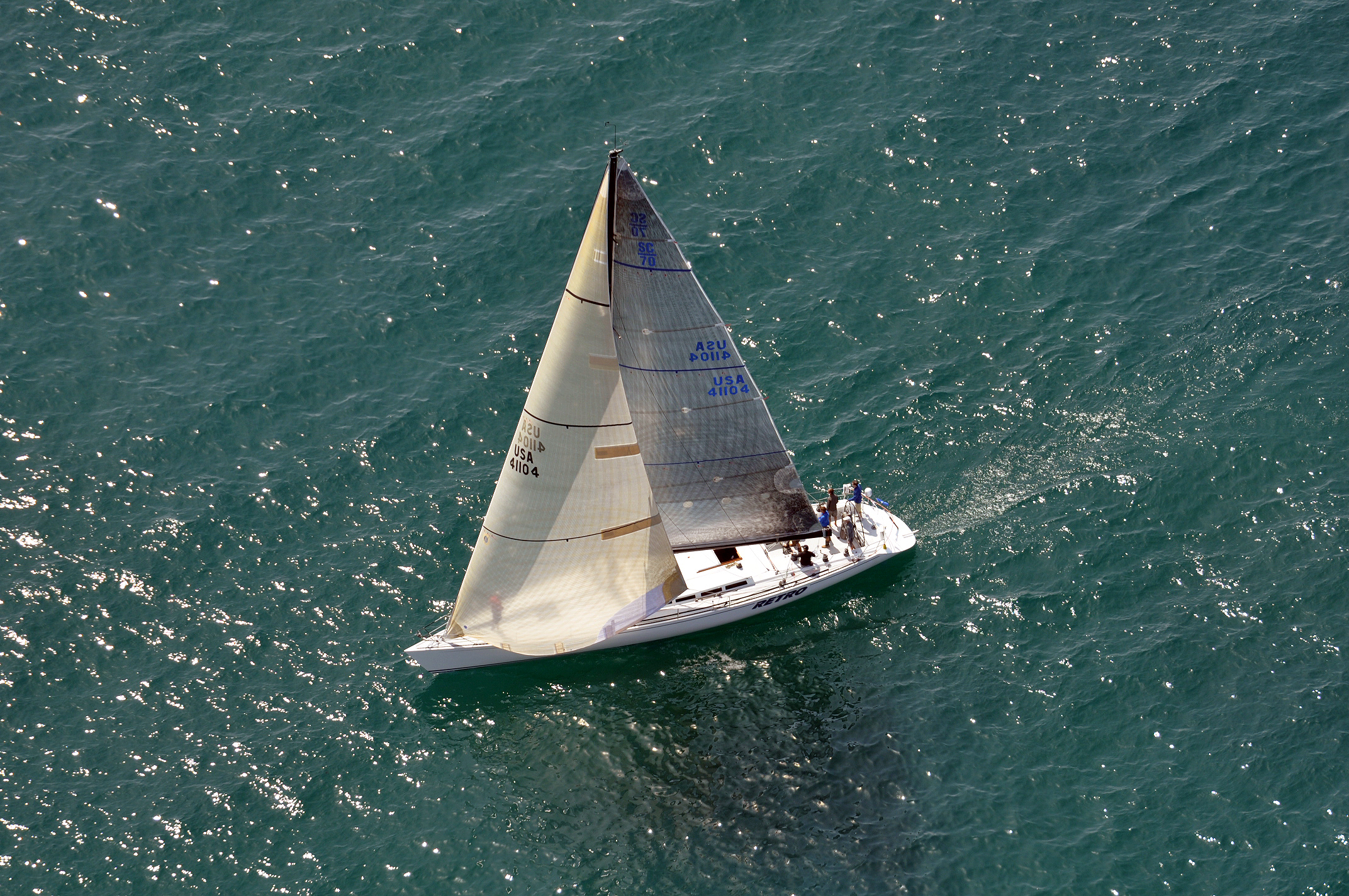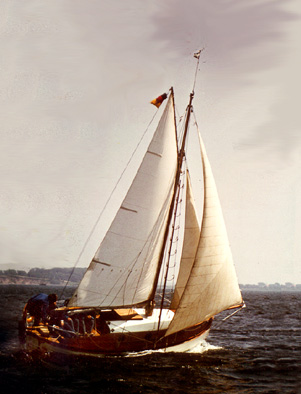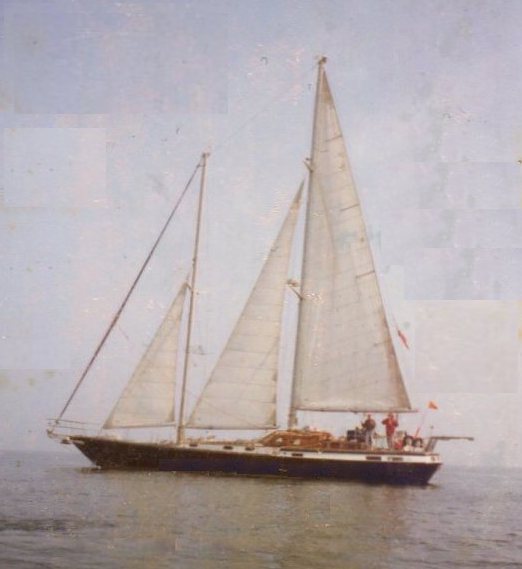|
Forestay
On a sailing vessel, a forestay, sometimes just called a stay, is a piece of standing rigging which keeps a mast from falling backwards. It is attached either at the very top of the mast, or in fractional rigs between about 1/8 and 1/4 from the top of the mast. The other end of the forestay is attached to the bow of the boat. Often a sail is attached to the forestay. This sail may be a jib or a genoa. In a cutter rig, the jib or jibs are flown from stays in front of the forestay, perhaps going from the masthead to a bowsprit. The sail on the forestay is then referred to as the staysail or stays'l. A forestay might be made from stainless steel wire on a modern yacht, solid stainless steel rod, carbon rod, or ultra high molecular weight polyethylene (such as Spectra or Dyneema) on a high-performance racing boat, and galvanised wire or natural fibers on an older cutter or square-rigged ship. See also * Backstay * Shroud (sailing) On a sailing ship, the shrouds are the ... [...More Info...] [...Related Items...] OR: [Wikipedia] [Google] [Baidu] |
Standing Rigging
Standing rigging comprises the fixed lines, wires, or rods, which support each mast or bowsprit on a sailing vessel and reinforce those spars against wind loads transferred from the sails. This term is used in contrast to running rigging, which represents the moveable elements of rigging which adjust the position and shape of the sails. Historical development Early sailing vessels used rope of hemp or other fibers, which gave way to wire ropes of various types. Galvanized steel was common for the first half of the 20th century, continuing as an inexpensive option to its 1960s successor material—stainless steel cables and rods. In the late 20th Century, racing yachts adopted composite fiber lines for standing rigging, with the goal of reducing weight and windage aloft. Materials On modern yachts, standing rigging is often stainless steel wire, Nitronic-50 stainless steel rod or synthetic fiber Synthetic fibers or synthetic fibres (in British English; see spelling ... [...More Info...] [...Related Items...] OR: [Wikipedia] [Google] [Baidu] |
Sailing
Sailing employs the wind—acting on sails, wingsails or kites—to propel a craft on the surface of the ''water'' (sailing ship, sailboat, raft, Windsurfing, windsurfer, or Kitesurfing, kitesurfer), on ''ice'' (iceboat) or on ''land'' (Land sailing, land yacht) over a chosen Course (navigation), course, which is often part of a larger plan of navigation. From prehistory until the second half of the 19th century, sailing craft were the primary means of maritime trade and transportation; exploration across the seas and oceans was reliant on sail for anything other than the shortest distances. Naval power in this period used sail to varying degrees depending on the current technology, culminating in the gun-armed sailing warships of the Age of Sail. Sail was slowly replaced by steam as the method of propulsion for ships over the latter part of the 19th century – seeing a gradual improvement in the technology of steam through a number of developmental steps. Steam allowed schedul ... [...More Info...] [...Related Items...] OR: [Wikipedia] [Google] [Baidu] |
Mast (sailing)
The mast of a sailing vessel is a tall spar, or arrangement of spars, erected more or less vertically on the median line of a ship or boat. Its purposes include carrying sails, spars, and derricks, giving necessary height to a navigation light, look-out position, signal yard, control position, radio aerial, or signal lamp. Large ships have several masts, with the size and configuration depending on the style of ship. Nearly all sailing masts are guyed. Until the mid-19th century, all vessels' masts were made of wood formed from a single or several pieces of timber which typically consisted of the trunk of a conifer tree. From the 16th century, vessels were often built of a size requiring masts taller and thicker than from single tree trunks. On these larger vessels, to achieve the required height, the masts were built from up to four sections (also called masts). From lowest to highest, these were called: lower, top, topgallant, and royal masts. Giving the lower section ... [...More Info...] [...Related Items...] OR: [Wikipedia] [Google] [Baidu] |
Fractional Rig
A fractional rig on a sailing vessel consists of a foresail, such as a jib or genoa sail, that does not reach all the way to the top of the mast. The forestay is a wire that secures the mast to the front of the boat. With a fractional rig, the forestay is attached between about 1/8 and 1/4 of the length of the mast lower down, rather than being attached to the top of the mast as in a masthead rig. The foresail (jib or genoa) is then rigged to this stay. The mast is farther forward on the boat than on a masthead rig and so it has a larger mainsail. Masthead rigs are most common on larger keelboats or cruisers. A fractional rig is typically used on sailing dinghies and racing oriented keelboats, such as the J/24. Fractional rigs were introduced on race boats in order to allow more controllability of the surface of the mainsail and also less drag when sailing upwind. According to one manufacturer, "a key to making fast boats easier to sail than slow boats is the 'fraction ... [...More Info...] [...Related Items...] OR: [Wikipedia] [Google] [Baidu] |
Bow (ship)
The bow () is the forward part of the hull of a ship or boat, the point that is usually most forward when the vessel is underway. The aft end of the boat is the stern. Prow may be used as a synonym for bow or it may mean the forward-most part of the bow above the waterline. Function A ship's bow should be designed to enable the hull to pass efficiently through the water. Bow shapes vary according to the speed of the boat, the seas or waterways being navigated, and the vessel's function. Where sea conditions are likely to promote pitching, it is useful if the bow provides reserve buoyancy; a flared bow (a raked stem with flared topsides) is ideal to reduce the amount of water shipped over the bow. Ideally, the bow should reduce the resistance and should be tall enough to prevent water from regularly washing over the top of it. Large commercial barges on inland waterways rarely meet big waves and may have remarkably little freeboard at the bow, whereas fast military ... [...More Info...] [...Related Items...] OR: [Wikipedia] [Google] [Baidu] |
Sail
A sail is a tensile structure, which is made from fabric or other membrane materials, that uses wind power to propel sailing craft, including sailing ships, sailboats, windsurfers, ice boats, and even sail-powered land vehicles. Sails may be made from a combination of woven materials—including canvas or polyester cloth, laminated membranes or bonded filaments, usually in a three- or four-sided shape. A sail provides propulsive force via a combination of lift and drag, depending on its angle of attack, its angle with respect to the apparent wind. Apparent wind is the air velocity experienced on the moving craft and is the combined effect of the true wind velocity with the velocity of the sailing craft. Angle of attack is often constrained by the sailing craft's orientation to the wind or point of sail. On points of sail where it is possible to align the leading edge of the sail with the apparent wind, the sail may act as an airfoil, generating propulsive force as air pa ... [...More Info...] [...Related Items...] OR: [Wikipedia] [Google] [Baidu] |
Genoa (sail)
A genoa sail is a type of large jib or staysail that extends past the mast and so overlaps the main sail when viewed from the side, sometimes eliminating it. It was originally called an "overlapping jib" and later a genoa jib. It is used on single-masted sloops and twin-masted boats such as yawls and ketches. Its larger surface area increases the speed of the craft in light to moderate winds; in high wind, a smaller jib is usually substituted, and downwind a spinnaker may be used. Definition The term ''jib'' is the generic term for any of an assortment of ''headsails''. The term ''genoa'' (or genny) refers to a type of jib that is larger than 100% of the foretriangle, which is the triangular area formed by the point at which the stay intersects the mast (sailing), mast, and deck (ship), deck or bowsprit, and the line where the mast (sailing), mast intersects deck (ship), deck at the rail. Colloquially the term is sometimes used interchangeably with ''jib''. A working jib is no la ... [...More Info...] [...Related Items...] OR: [Wikipedia] [Google] [Baidu] |
Cutter (ship)
A cutter is any of various types of watercraft. The term can refer to the rig (sail plan) of a sailing vessel (but with regional differences in definition), to a governmental enforcement agency vessel (such as a coast guard or border force cutter), to a type of ship's boat which can be used under sail or oars, or, historically, to a type of fast-sailing vessel introduced in the 18th century, some of which were used as small warships. As a sailing rig, a cutter is a single-masted boat, with two or more headsails. On the eastern side of the Atlantic, the two headsails on a single mast is the fullest extent of the modern definition. In U.S. waters, a greater level of complexity applies, with the placement of the mast and the rigging details of the bowsprit taken into account so a boat with two headsails may be classed as a sloop. Government agencies use the term "cutter" for vessels employed in patrolling their territorial waters and other enforcement activities. This terminol ... [...More Info...] [...Related Items...] OR: [Wikipedia] [Google] [Baidu] |
Bowsprit
The bowsprit of a sailing vessel is a spar (sailing), spar extending forward from the vessel's prow. The bowsprit is typically held down by a bobstay that counteracts the forces from the forestay, forestays. The bowsprit’s purpose is to create anchor points for the sails that extend beyond the vessel’s bow, increasing the size of sail that may be held taut. The word ''bowsprit'' is thought to originate from the Middle Low German word ''bōchsprēt'' – ''bōch'' meaning "bow" and ''sprēt'' meaning "pole". On some square-rigged ships a Spritsail (square-rigged), spritsail is flown below the bowsprit; these are sometimes accompanied by a sprit topmast, which serves to assist the spritsail while tacking (sailing), tacking. The bowsprit may also be used to hold up the Figurehead (object), figurehead. References External links * {{Sailing ship elements Sailboat components ... [...More Info...] [...Related Items...] OR: [Wikipedia] [Google] [Baidu] |
Staysail
A staysail ("stays'l") is a fore-and-aft rigged sail whose luff can be affixed to a stay running forward (and most often but not always downwards) from a mast to the deck, the bowsprit, or to another mast. Description Most staysails are triangular; however, some are four-cornered, notably some fisherman's staysails. Triangular staysails set forward of the foremost mast are called jibs, headsails, or foresails. The innermost such sail on a cutter, schooner, and many other rigs having two or more foresails is referred to simply as ''the staysail'', while the others are referred to as jibs, flying jibs, etc. Types of staysail include the tallboy staysail (a narrow staysail carried between the spinnaker and the mainsail on racing yachts), the genoa staysail (a larger one carried inside the spinnaker when broad reaching), and the bigboy staysail (another name for the shooter or blooper, carried on the leeward side of the spinnaker). Unlike the cutter staysail, none of ... [...More Info...] [...Related Items...] OR: [Wikipedia] [Google] [Baidu] |
Ultra High Molecular Weight Polyethylene
Ultra-high-molecular-weight polyethylene (UHMWPE, UHMW) is a subset of the thermoplastic polyethylene. Also known as high-modulus polyethylene (HMPE), it has extremely long chains, with a molecular mass typically between 2 and 6 million amu. The longer chain serves to transfer load more effectively to the polymer backbone by strengthening intermolecular interactions. This results in a very tough material, with the highest impact strength of any thermoplastic presently made. UHMWPE is odorless, tasteless, and nontoxic. It embodies all the characteristics of high-density polyethylene (HDPE) with the added traits of being resistant to concentrated acids and alkalis, as well as numerous organic solvents. It is highly resistant to corrosive chemicals except oxidizing acids; has extremely low moisture absorption and a very low coefficient of friction; is self-lubricating (see boundary lubrication); and is highly resistant to abrasion, in some forms being 15 times more resistant to a ... [...More Info...] [...Related Items...] OR: [Wikipedia] [Google] [Baidu] |
Backstay
A backstay is a piece of standing rigging on a sailing vessel that runs from the mast to either its transom or rear quarter, counteracting the forestay and jib. It is an important sail trim control and has a direct effect on the shape of the mainsail and the headsail. Backstays are generally adjusted by block and tackle, hydraulic adjusters, or lines leading to winches. Types Backstays may be ''permanent'' or ''running''. Permanent backstay A permanent backstay is attached to the top of the mast. Running backstays appear in pairs attached about two-thirds of the way up the mast (sometimes at multiple locations along the length of the mast). In general, most modern sailboats have a permanent backstay and some have a permanent backstay combined with running backstays. Backstays are not always found on all vessels, especially smaller ones. A permanent backstay is attached at the top of the mast and may or may not be readily adjustable. In a masthead rig, tensioning the perma ... [...More Info...] [...Related Items...] OR: [Wikipedia] [Google] [Baidu] |
